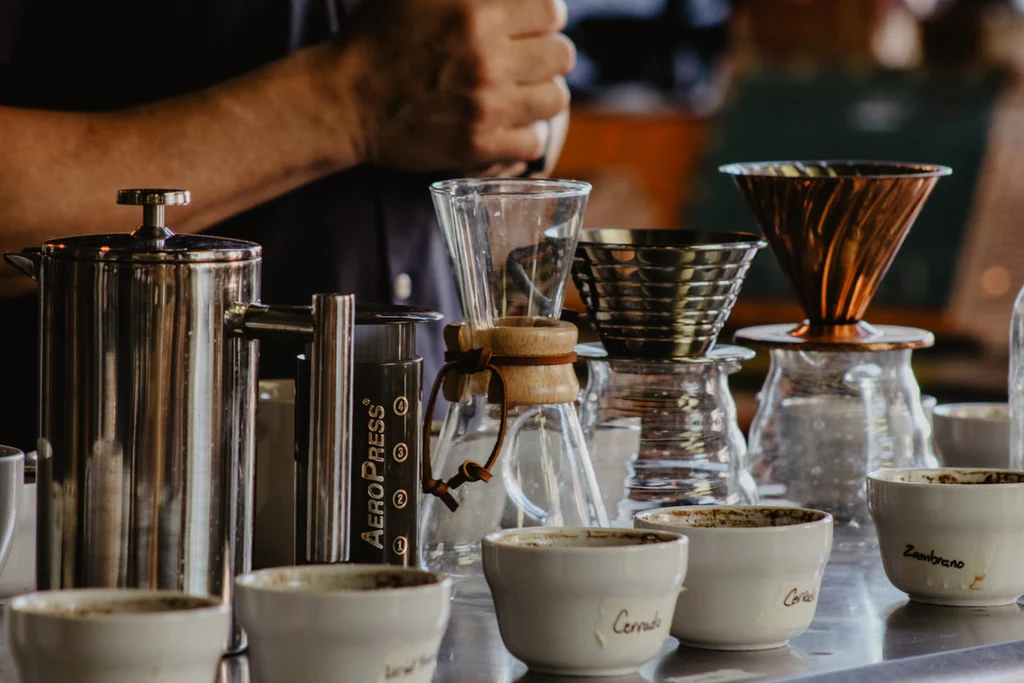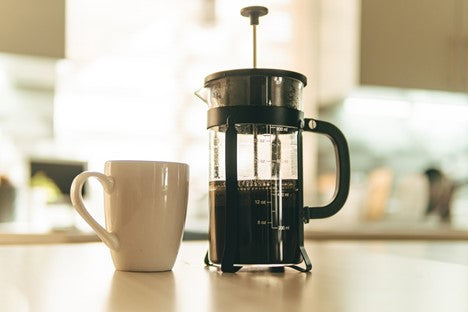
Many prefer their coffee prepared by a professional at a cafe, but many love to brew their own cup of coffee freshly at home.
Various coffee brewing methods have been introduced throughout the years, but only a few of them are widely popular for their ease of preparation and quick extraction.
This guide will help you understand four different types of widely popular coffee brewing methods and their preparation.
French-press:

French-Press is the simplest, effective, and most popular coffee brewing method. It is a simple device preferred by many coffee lovers because of its easy-to-use design for preparing a rich cup of coffee.
The design includes a narrow cylindrical glass or plastic pot equipped with a plunger made of plastic or metal and a mesh filter.
The original design was simple than its modern version, where cheesecloth was fitted to a rod for pressing the coffee and filtering the coffee grounds.
This coffee brewing method allows you to experiment with your flavour. You can do so by adjusting the brewing time, grind size, and water temperature. French-Press coffee has a fuller body as the saturated grounds extract the maximum flavour in this immersion brew method.
Using the perfect grind is also important for this kind of preparation. A medium-coarse ground clogs the filter, and the fine ground does not filter and end up in your cup. Therefore, it is advised to use coarse grounds for better results.
The no-filter requirement makes it an ideal and simple method of yielding a fresh cup of flavorful, aromatic, full-bodied coffee.
How to make French-Press coffee:

Step1: The first step to brewing your coffee with French-Press is by preheating the carafe. Preheating will make sure that your French-Press is warm for a longer time, allowing the coffee flavours to come out well. You can use any bean for this method, though most professionals advice to use medium or dark roasted coffee beans.
Step 2: Boil the water at a temperature of 195–200-degree Fahrenheit. Use a thermometer to measure the temperature.
Step 3: Grind your coffee beans immediately. Flavourful oils from the coffee grounds begin to oxidize from the moment you grind them. Fresh coffee grounds give a much flavourful and aromatic cup of coffee.
Step 4: Take out the warm water (from the preheating process, step 1) and empty the carafe. Then put coffee grounds into the carafe. Use the number of coffee grounds based on how strong you want your coffee. As a reference, you can use 30 g of coffee for 500 ml of water.
Step 5: Add the boiled water (from step 2) and stir the mixture.
Step 6: Place the plunger and move up the rod to keep the heat trapped. Wait for 3-5 minutes to steep the coffee before moving further with the preparation, as it will allow the grounds to settle.
Step 7: Press the plunger slowly to move the coffee grounds to the bottom of the carafe. It is important to push the plunger slowly to ensure that the undissolved grounds get filtered through the mesh filter.
Step 8: Serve the coffee immediately to avoid the continuous addition of bitter flavours to your drink.
Step 9: After serving your coffee, make sure to clean the carafe.
Pour-Over

The Pour-Over method is a manual coffee brewing method. It is a popular choice in the speciality coffee scene and a preferred choice for black coffee lovers. The process requires paper filters that slowly drip a flavourful cup of coffee.
Related Read: What makes specialty coffee, special?
The pour-over device has a simple design that includes a cup, filter, pour-over dripper.
As it highlights the complex flavour, it is a preferred choice for single-origin coffee.
Another factor that makes this brewing method not so favoured is the papery taste from the paper filters gives a muddy flavour to the coffee.
Although many beginners would see it as an easy method, don’t expect to break down this method on your first try.
How to make pour-over coffee

Step 1: Grind your coffee beans to a coarse texture. For the Pour-over method, light to medium roast beans are highly preferred as the beans roasted to this profile are the brightest and most acidic to its flavours.
Step 2: Boil 500 ml water for 30g of coffee grounds at a temperature of 195–205-degree Fahrenheit. The pour-over method requires water boiled at a high temperature for the slow extraction of the flavours. It is important to note that the better the quality of the water, the better your coffee turns out. You can use filtered water or take a reference of the water quality standards set by SCA.
Step 3: Wet the filter before use as it helps to avoid the papery taste. Place the filter on the carafe.
Step 4: Put your ground coffee and gently tap it to even the level. For accurate measurement, place the carafe on a scale.
Step 5: Slowly pour a small amount of water, enough to cover the coffee ground. Make sure to pour the water in a spiral motion (centre and then on the sides) for better saturation of the grounds and extraction of the flavours. Wait for some time to let the carbon dioxide escape and for the coffee to bloom, and then add a small amount of water again. Repeat this step by taking 3-4 turns.
AeroPress

AeroPress is the latest device developed by Aerobie for brewing coffee by applying pressure. The design includes a cylindrical device made of plastic, including a brew chamber, a plunger, and an airtight silicone lid.
The steeping takes place in the brew chamber, where the coffee grounds and filter rests and later are immersed with water. A plunger is then pressed down for extraction, creating air pressure to force brewed coffee through a filter and into a cup.
Compared to other coffee brewing methods, AeroPress takes just 1-2 minutes for preparation, making it a preferred choice among people who like their coffee to be ready in less time. This method gives a sweet, concentrated, espresso-style, full-bodied cup of coffee. It is simple, cost-effective, and easy to carry along when travelling.
How to make AeroPress coffee

Step 1: Grind your coffee beans to a fine-medium texture for a better extraction from this process. Use an espresso blend or dark roast coffee beans coffee beans for this method to taste all the flavours of the brewed coffee.
Step 2: Boil 500 ml of water for 30 g of coffee grounds at a temperature of 200-degree Fahrenheit.
Step 3: Wet the filter (to avoid paper taste) and place it in the cap. Then put the cap back on the chamber.
Step 4: Add your coffee grounds and shake the chamber to even the level and wet it with the water. Following this, stir the mixture properly.
Step 5: Now place the plunger back on (invert it if you notice that your mixture is leaking) and press it until you feel the resistance. After a short time, you will hear a hissing sound, indicating that there is no more water left for extraction and that your coffee is ready.
Step 6: Enjoy a freshly prepared cup of espresso-style coffee and clean the carafe thoroughly afterwards.
Espresso

Although many might think it is just another type of coffee, espresso is a method of preparation. Invented in Italy, the word directly translates to “express” in Italian. The espresso is prepared by passing a 9-bar of pressure through finely-ground coffee. The resulting drink made using this coffee brewing method is a thick and concentrated coffee that has a crema (foamy layer) on the top.
Suspended and dissolved solids are the result of a faster extraction in a short time. The preparation with this method is the quickest as it takes just 20-30 seconds compared to other brewing methods. Espresso serves as a base for many coffee drinks.
The espresso machines available in the market falls at the high end of the cost spectrum. It is bulky in size and requires a lot of maintenance.
Related Read: IS NESPRESSO COFFEE OR ESPRESSO?
Most café and coffee shops use espresso as a coffee brewing method because of its quick extraction.
How to make espresso coffee

Step 1: Use a light roast coffee bean to grind it to a fine-medium texture. The darker the roast, the more bitter your coffee will turn out. So, to enjoy a delicious cup of espresso, experts advise using a light roast. A fine-medium texture is important for espresso preparation. Coarse grounds give you a thin drink and very fine coffee grounds, a charcoal-smelly drink.

Step 2: Place 7-8 g of coffee grounds for a single shot of espresso (for double shot, use 14-16 g) in the removable filter on the espresso machine (portafilter basket) and tamp the grounds. Tamping is essential for getting a rich cup of espresso as it ensures an even flow of water through the grounds. Nowadays, many brands have automatic tamping.
Related Read: Espresso shot- Is it stronger than a regular cup of coffee?
Is a shot of espresso good for you?
Step 3: Keep a close eye on the machine to extract the espresso at the right moment. Instantly extract the drink when you notice a golden brown colour with dark oils. The golden brown colour means your coffee is well extracted and has a bittersweet profile. Any other colour means that either your coffee is under-extracted or over-extracted.
Shop premium quality roasted coffee beans available in different roast formats at our Don Carlos store. The beans have been expertly roasted to fulfil the requirement of all the demanding palates.
If you have no time for roasting your coffee beans, you can instead use already grounded coffee. At Don Carlos we have an array of options available for ground coffee made from selected varieties of Arabica and high-grade Robusta. We also have decaffeinated ground coffee, made from selective full-bodied coffee beans